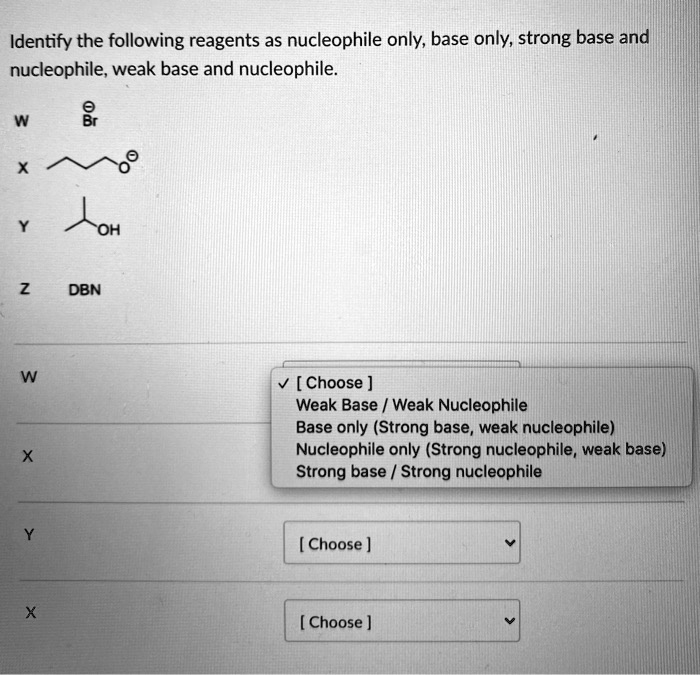Identify the following reagents as nucleophile only, base only, strong base and nucleophile; weak base and nucleophile: OH DBN [Choose ] Weak Base Weak Nucleophile Base only (Strong base, weak nucleophile) Nucleophile only (Strong nucleophile, weak base) Strong base Strong nucleophile [Choose ] [Choose

The Correct Answer and Explanation is:
Based on the principles of organic chemistry regarding basicity and nucleophilicity, here are the correct classifications for the given reagents. The last entry in the question, labeled “X”, is assumed to be a typo and should be “Z” to correspond with the four unique reagents listed.
- W (Br⁻): Nucleophile only (Strong nucleophile, weak base)
- X (Butoxide ion): Strong base / Strong nucleophile
- Y (Isopropyl alcohol): Weak Base / Weak Nucleophile
- Z (DBN): Base only (Strong base, weak nucleophile)
Explanation:
W (Br⁻, Bromide ion): Bromide is the conjugate base of hydrobromic acid (HBr), which is a very strong acid. Consequently, Br⁻ is a very weak base and is unlikely to abstract a proton in typical reactions. However, it is a good nucleophile because it is a relatively large, polarizable anion that can readily donate its electron pair to an electrophilic carbon atom. Therefore, it is classified as a strong nucleophile and a weak base.
X (Butoxide ion): This reagent is an alkoxide, the conjugate base of butanol, an alcohol. Alcohols are weak acids (pKa ≈ 16-18), which means their conjugate bases, alkoxides, are strong bases. The butoxide ion has a negative charge on the oxygen atom and is not sterically hindered, allowing it to easily attack both protons (acting as a base) and electrophilic carbons (acting as a nucleophile). Thus, it is both a strong base and a strong nucleophile.
Y (Isopropyl alcohol): This is a neutral alcohol molecule. As a neutral species, it is both a weak nucleophile and a weak base. The lone pairs on the oxygen can act as a nucleophile, but its lack of a negative charge makes it much less reactive than an alkoxide. It will typically only react with strong electrophiles or act as a solvent in reactions like SN1, where a weak nucleophile is favored. Its basicity is also very low.
Z (DBN, 1,5-Diazabicyclo[4.3.0]non-5-ene): DBN is a bicyclic amidine and is a classic example of a sterically hindered, non-nucleophilic strong base. Its bulky structure prevents the nitrogen’s lone pair from accessing and attacking an electrophilic carbon atom, making it a very poor nucleophile. However, it is an effective strong base because it can easily abstract a proton. These types of bases are specifically designed to promote elimination reactions over substitution reactions.
